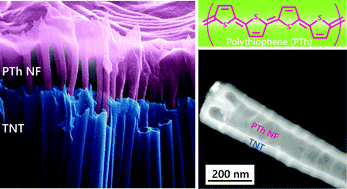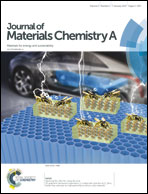Controlled growth of polythiophene nanofibers in TiO2 nanotube arrays for supercapacitor applications†
Abstract
One-dimensional (1D) nanostructured materials have attracted intense interest because they are superior for applications when compared to their bulk counterparts, owing to their unique and fascinating properties. We thus demonstrate the development of conducting 1D polythiophene (PTh) nanofibers in hollow TiO2 nanotube arrays (TNTs) by controlling nucleation and growth during the electropolymerization of the thiophene monomer. The progression of nanofiber (NF) formation in the hollow interiors of the TNTs follows a three-dimensional instantaneous nucleation and growth mode, in which the polymer grows at a rate that does not allow for the build-up of the polymer on new polymerization sites, but only on existing ones. The formation of highly conductive dienes of PTh is confirmed, with increased conjugation in PTh NFs grown in the confined matrix of TNTs. These 1D PTh–TNT NFs show potential as a promising supercapacitor electrode material, exhibiting a high specific capacitance of 1052 F g−1, which clearly highlights their importance as potential next-generation charge storage entities.

- This article is part of the themed collection: 2016 Journal of Materials Chemistry A HOT Papers


 Please wait while we load your content...
Please wait while we load your content...